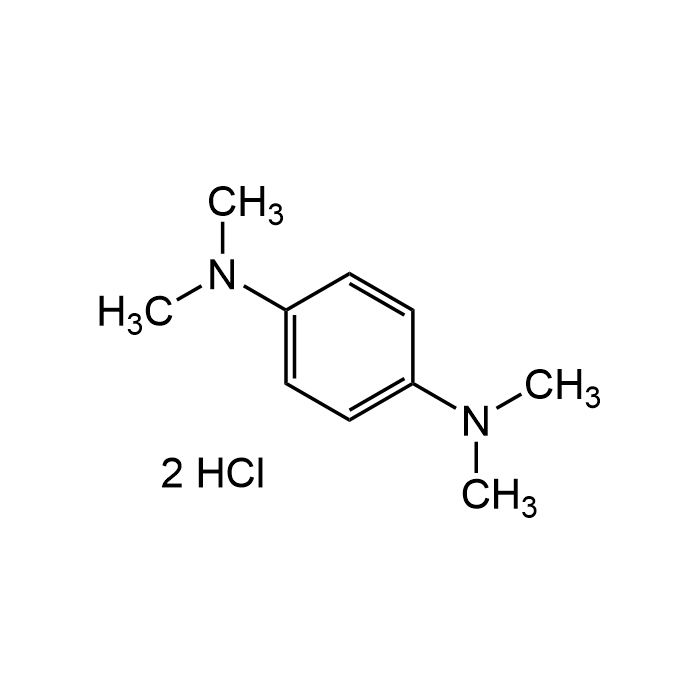Cookie Policy: This site uses cookies to improve your experience. You can find out more about our use of cookies in our Privacy Policy. By continuing to browse this site you agree to our use of cookies.
Chemodex
N,N,N',N'-Tetramethyl-p-phenylenediamine dihydrochloride
As low as
58
CHF
CHF 58.00
In stock
Only %1 left
CDX-T0511-G0055 gCHF 58.00
CDX-T0511-G02525 gCHF 232.00

| Product Details | |
|---|---|
| Synonyms | TMPD; Tetramethyl-p-phenylenediamine dihydrochloride; Wurster's reagent dihydrochloride; 1,4-Bis(dimethylamino)benzene dihydrochloride |
| Product Type | Chemical |
| Properties | |
| Formula | C10H18Cl2N2 |
| MW | 237.17 |
| CAS | 637-01-4 |
| Source/Host Chemicals | Synthetic |
| Purity Chemicals | ≥95% (NMR) |
| Appearance | Pale-yellow solid. |
| Solubility | Soluble in water (50mg/ml). |
| Identity | Determined by 1H-NMR. |
| Declaration | Manufactured by Chemodex. |
| Other Product Data |
Click here for Original Manufacturer Product Datasheet |
| InChi Key | FBHKTSXMTASXFJ-UHFFFAOYSA-N |
| Smiles | N(C)(C)C1=CC=C(N(C)C)C=C1.Cl |
| Shipping and Handling | |
| Shipping | AMBIENT |
| Short Term Storage | +20°C |
| Long Term Storage | +20°C |
| Handling Advice | Protect from light and moisture. |
| Use/Stability | Stable for at least 2 years after receipt when stored at RT. |
| Documents | |
| Product Specification Sheet | |
| Datasheet |
 Download PDF Download PDF |
Description
N,N,N',N'-Tetramethyl-p-phenylenediamine dihydrochloride (TMPD) is a redox-active aromatic amine compound, widely used in biochemical and analytical applications, particularly as a chromogenic redox indicator. TMPD is commonly used in redox titrations and biochemical assays. It is colorless in its reduced form and turns blue or purple (called Wurster's Blue) upon oxidation, indicating electron transfer activity. This makes it valuable for detecting the presence or activity of oxidases or cytochromes. TMPD serves as an artificial electron donor, particularly to cytochrome c oxidase (complex IV) in the mitochondrial electron transport chain. It's often used in combination with ascorbate to assess respiratory chain function. TMPD is used in colorimetric assays for peroxidase activity or other oxidoreductases, where a color change signals enzyme action.
Product References
(1) M.G. Mustafa & T.E. King; Arch. Biochem. Biophys. 122, 501 (1967) | (2) H.K. Kimelberg & P. Nicholls; Arch. Biochem. Biophys. 133, 327 (1969) | (3) S. Papa, et al.; FEBS Lett. 157, 15 (1983) | (4) R. Munday; Chem. Biol. Interact. 65, 133 (1988) | (5) R.M. Lorence, et al.; J. Biol. Chem. 263, 5271 (1988) | (6) E.W. de Vrind-de Jong, et al.; Appl. Environ. Microbiol. 56, 3458 (1990) | (7) C. Storle & P. Eyer; Chem. Biol. Interact. 78, 321 (1991) | (8) N. Petrovic & M. Murray; Methods Mol. Biol. 594, 129 (2010)





